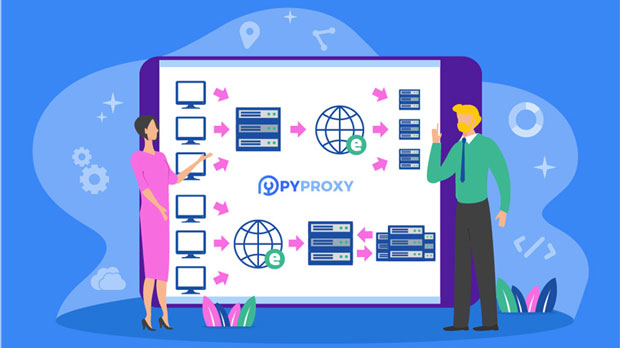In the world of residential proxies, two notable services often come up in discussions: PYPROXY and ProxyProxy. These services provide users with IP addresses that are associated with real residential devices, offering a more natural way to hide one’s identity online compared to traditional data center proxies. However, they differ significantly in terms of coverage, availability, and the overall user experience. In this article, we will compare PyProxy and ProxyProxy with a focus on their residential proxy service coverage, examining the geographical reach, scalability, reliability, and other factors that make these services stand out in the competitive market. Geographical Coverage and Network ReachWhen selecting a residential proxy provider, one of the key aspects to consider is the geographical coverage of their network. Both PyProxy and ProxyProxy offer a wide range of locations, but there are some notable differences.PyProxy, for instance, has an expansive network that spans multiple countries across all continents. They pride themselves on their global reach, particularly excelling in emerging markets such as Southeast Asia, Eastern Europe, and parts of Africa. This broad geographic coverage makes PyProxy an appealing choice for businesses and individuals who need to access content from diverse regions.On the other hand, ProxyProxy also offers worldwide coverage, but it tends to focus more on North America, Europe, and certain parts of Asia. While it may not have the same extensive reach in developing regions, its focus on more developed markets allows it to offer high-quality, stable proxies in these areas.Scalability of Proxy NetworksScalability is another important factor to consider when evaluating proxy services. As businesses grow and their needs increase, they require a service that can scale to accommodate larger demands without compromising on performance.PyProxy’s network is known for its scalability. The company offers flexible pricing and can easily adjust the number of residential IPs to suit both small and large businesses. This flexibility allows companies to increase or decrease their usage based on demand, without facing significant hurdles.ProxyProxy also offers scalable solutions, but it tends to focus on more specific use cases. While it can scale for large projects, the service is primarily optimized for medium-sized businesses or individuals who don’t require massive proxy pools. However, ProxyProxy does offer customizable plans that can cater to varying levels of usage, making it a solid choice for businesses looking to grow incrementally.Reliability and SpeedReliability and speed are crucial factors for residential proxy services. Users expect fast and stable connections, as proxies are often used for high-stakes tasks like data scraping, market research, and bypassing geo-restrictions.PyProxy is known for its strong reliability and consistent speeds. With a diverse pool of residential IP addresses, the service can distribute traffic across multiple nodes, ensuring that users experience minimal downtime and stable speeds. Additionally, PyProxy invests heavily in maintaining its network infrastructure, ensuring that there are always available proxies when needed.ProxyProxy, on the other hand, provides reliable service, though it may not always match PyProxy’s speed, particularly during peak usage times. While the service does offer high-speed proxies in key markets, users in more remote locations might experience slower speeds or increased latency. This is something that ProxyProxy continues to work on improving, but it’s still a factor to consider when choosing between the two services.Security and AnonymityWhen dealing with residential proxies, security and anonymity are paramount. Users need to ensure that their online activities remain private and that the proxies they are using do not expose them to unnecessary risks.PyProxy provides a high level of security by encrypting data transmission and ensuring that all residential IP addresses are sourced from legitimate devices. The company uses advanced techniques to ensure that users’ actions remain anonymous, making it a top choice for those who need to maintain privacy while browsing or conducting online operations.ProxyProxy also places a strong emphasis on security, utilizing state-of-the-art encryption protocols. However, some users have reported concerns regarding the transparency of its security measures. While the service does take steps to secure user data, it is not as widely regarded for its anonymity features as PyProxy.Pricing Structure and Value for MoneyPricing is an essential factor when deciding between PyProxy and ProxyProxy. Both services offer competitive pricing structures, but the value for money varies depending on the user’s needs.PyProxy’s pricing is tiered, allowing users to choose from various plans based on their budget and requirements. For businesses that require a large number of residential IPs, PyProxy provides discounts for bulk purchases. Additionally, PyProxy’s flexible pricing system allows users to start small and scale up as needed, making it an ideal choice for both startups and established companies.ProxyProxy’s pricing is similarly competitive, but it tends to be slightly higher compared to PyProxy, especially for smaller users or those requiring fewer IPs. However, the service does offer excellent customer support and tailored packages that make it a good choice for businesses seeking personalized assistance and specific solutions. The added value of customer service and dedicated support can make the slightly higher price worthwhile for some users.Customer Support and User ExperienceCustomer support is another critical area where PyProxy and ProxyProxy differ. While both services offer customer support channels, the quality and responsiveness can vary.PyProxy is widely praised for its customer service, with a dedicated team available 24/7 to assist with any issues. Users report quick response times and helpful guidance, making it easier to resolve any technical difficulties. Additionally, PyProxy offers a user-friendly interface, which simplifies the process of managing proxies and monitoring usage.ProxyProxy also offers reliable customer support, but some users have mentioned slower response times compared to PyProxy. While the support team is generally knowledgeable and helpful, there can be delays during peak times. Nonetheless, ProxyProxy is known for its comprehensive knowledge base, which can assist users in troubleshooting common issues independently.Both PyProxy and ProxyProxy provide robust residential proxy services, but the choice between the two depends largely on the specific needs of the user. PyProxy stands out for its extensive geographical coverage, scalability, and strong reliability, making it a great option for businesses or individuals with diverse needs and large-scale operations. Meanwhile, ProxyProxy offers excellent service for those targeting more developed markets, with a strong focus on security and customer support. Ultimately, the decision comes down to the user’s geographical focus, scalability needs, and budget.
Sep 04, 2025



































































